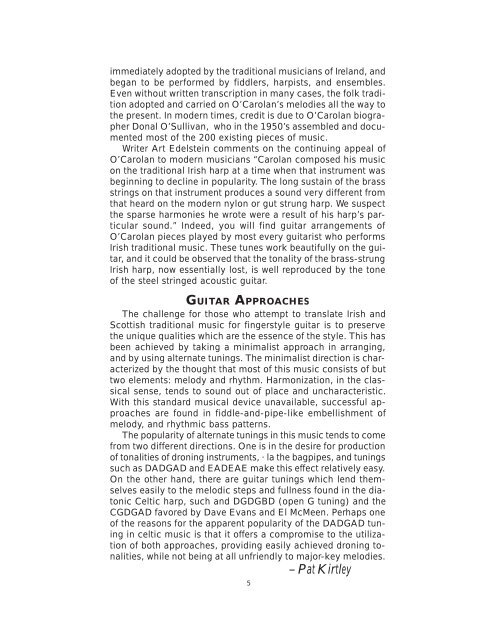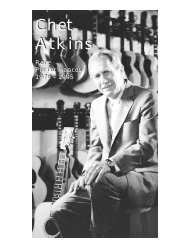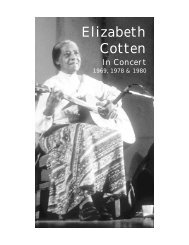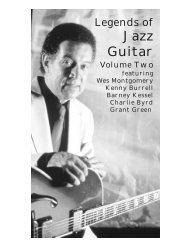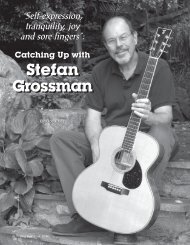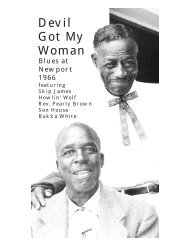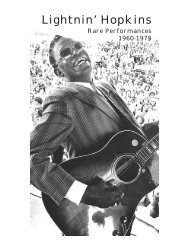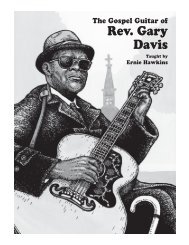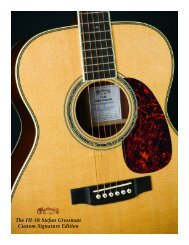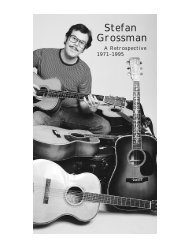Download PDF Booklet - Stefan Grossman's Guitar Workshop
Download PDF Booklet - Stefan Grossman's Guitar Workshop
Download PDF Booklet - Stefan Grossman's Guitar Workshop
You also want an ePaper? Increase the reach of your titles
YUMPU automatically turns print PDFs into web optimized ePapers that Google loves.
immediately adopted by the traditional musicians of Ireland, and<br />
began to be performed by fiddlers, harpists, and ensembles.<br />
Even without written transcription in many cases, the folk tradition<br />
adopted and carried on O’Carolan’s melodies all the way to<br />
the present. In modern times, credit is due to O’Carolan biographer<br />
Donal O’Sullivan, who in the 1950’s assembled and documented<br />
most of the 200 existing pieces of music.<br />
Writer Art Edelstein comments on the continuing appeal of<br />
O’Carolan to modern musicians “Carolan composed his music<br />
on the traditional Irish harp at a time when that instrument was<br />
beginning to decline in popularity. The long sustain of the brass<br />
strings on that instrument produces a sound very different from<br />
that heard on the modern nylon or gut strung harp. We suspect<br />
the sparse harmonies he wrote were a result of his harp’s particular<br />
sound.” Indeed, you will find guitar arrangements of<br />
O’Carolan pieces played by most every guitarist who performs<br />
Irish traditional music. These tunes work beautifully on the guitar,<br />
and it could be observed that the tonality of the brass-strung<br />
Irish harp, now essentially lost, is well reproduced by the tone<br />
of the steel stringed acoustic guitar.<br />
GUITAR APPROACHES<br />
The challenge for those who attempt to translate Irish and<br />
Scottish traditional music for fingerstyle guitar is to preserve<br />
the unique qualities which are the essence of the style. This has<br />
been achieved by taking a minimalist approach in arranging,<br />
and by using alternate tunings. The minimalist direction is characterized<br />
by the thought that most of this music consists of but<br />
two elements: melody and rhythm. Harmonization, in the classical<br />
sense, tends to sound out of place and uncharacteristic.<br />
With this standard musical device unavailable, successful approaches<br />
are found in fiddle-and-pipe-like embellishment of<br />
melody, and rhythmic bass patterns.<br />
The popularity of alternate tunings in this music tends to come<br />
from two different directions. One is in the desire for production<br />
of tonalities of droning instruments, · la the bagpipes, and tunings<br />
such as DADGAD and EADEAE make this effect relatively easy.<br />
On the other hand, there are guitar tunings which lend themselves<br />
easily to the melodic steps and fullness found in the diatonic<br />
Celtic harp, such and DGDGBD (open G tuning) and the<br />
CGDGAD favored by Dave Evans and El McMeen. Perhaps one<br />
of the reasons for the apparent popularity of the DADGAD tuning<br />
in celtic music is that it offers a compromise to the utilization<br />
of both approaches, providing easily achieved droning tonalities,<br />
while not being at all unfriendly to major-key melodies.<br />
– Pat Kirtley<br />
5


